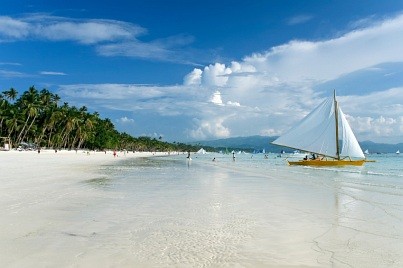 Boracay has grown up as a cosmopolitan place with influences from all over the world. People have returned here year after year from northern Europe and North America while the surfing scene has brought industry in from all over the world. English is widely spoken and routes in and out of the island are well traversed and inexpensive.
Boracay has grown up as a cosmopolitan place with influences from all over the world. People have returned here year after year from northern Europe and North America while the surfing scene has brought industry in from all over the world. English is widely spoken and routes in and out of the island are well traversed and inexpensive.The Philippines is a pretty relaxed place and laws regarding beach clothing that apply to most other countries in Southeast Asia do not apply here, especially not in Boracay. Sarongs are all that most places expect away from the beach, even at dinner, though more upscale places may request collars and/or shoes.
This is an international tourist island and alcohol consumption is par for the course as is a fairly relaxed attitude towards public displays of affection. Drugs are not permitted and laws can be severe for infractions of narcotics laws.
The Filipino peso (P) is the national currency of the Philippines and therefore the currency of Boracay. Low denomination greenbacks are also accepted at most places and single notes make handy tips for service professionals or ferry drivers.
Cash is required all over the island. Only the most upscale resorts on station 1 of Boracay White Beach will take credit cards while more or less none of the restaurants, outside of the hotels, will take anything but cash. Prices at restaurants are fixed but shops and low budget accommodations are happy to negotiate prices.
Boracay enjoys, or some would say suffers, through the turbulent climate of the Philippines. The wet season starts in May and runs through to October and some weeks of this period are violently inclement. Typhoons and monsoons are not uncommon and transfers by sea are often interrupted if not cancelled during this time.
The winds that blow from the north and south are what provide Boracay with its superlative and world renowned surfing and windsurfing scene. During the dry season which runs from December to March, winds are low and humidity is comparatively reduced.
Most people arrive at Boracay by sea. Outriggers shuttle between Caticlan and Boracay landing on the east coast at Bulabog during the monsoon season or heavily inclement weather. Caticlan can be reached by air from Manila via Cebu Pacific, a great little budget carrier. A lot of visitors reach Boracay as part of an island-hopping trip that takes in Cebu and Negros.
Boracay is easy to explore on foot. It is less than nine kilometers long and the entire island can be crossed in 15 minutes or less. Trikes can be rented as well as mountain bikes for cheap daily rates and some more adventurous travelers spring for a motor cycle. There are regular boat services to offshore islands and diving spots.
Population: 12,000
Spoken languages: Filipino, Tagalog, Spanish, English
Electrical: 220-240 Volts, 50 Hertz
Phone/calling code: +63 36
Find more information about Boracay and hotels in the area:
Boracay hotels | Philippines hotels